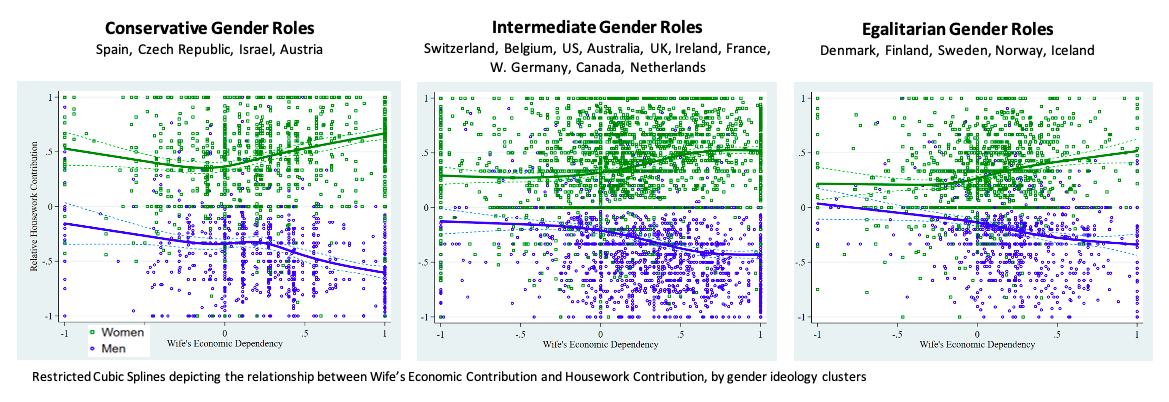Using integrated data on individuals and occupations from the US Census (1960-2010) and the ACS surveys (2001-2015), the findings show, similarly to previous studies, that in recent decades, and especially from 1980 onwards, a growing number of women in the US have approached the head of the occupational ladder. This shift has been fuelled by women’s growing educational attainments, which, together with the rising economic premium to education, have greatly contributed to the decline in gender wage gaps. Furthermore, based on these changes, the negative association between female percentage in occupations and occupational pay levels declines over time (see model 1 in the figure). This decline is most apparent from 1980 onward, a period in which US women witnessed a significant improvement in their occupational standing, and a period where occupations requiring higher education enjoyed a large wage premium. However, when examining the effect of gender composition of the occupation after accounting for women’s higher education and for the level of education in occupations, the trend is reversed; the negative net effect of female percentage on occupational pay intensifies over time (see model 2 in the figure). These two opposite processes reflect the upward occupational mobility of women, on the one hand, and its gendered consequences, on the other hand.
Mandel, Hadas. 2018. A Second Look at the Process of Occupational Feminization and Pay Reduction in Occupations. Demography, 55(2): 669-690.
For the full article click here

The paper explores cross-country
variation in the relationship between division of housework and wives’ relative
economic contribution. We examined the effect of two contextual factors:
women’s labor force participation rate, which we link to economic exchange
theories; and gender ideology context, which we link to cultural theories.
While economic exchange proponents assert that housework the division of
housework stems from a rational negotiation between the spouses, based on their
relative economic position cultural theories explains the division of labor
between wives and husbands in terms of gender relations, manifested and
reaffirmed by symbolic presentations of gender roles. In order to adjust to the
prevailing cultural and social norms, working wives do most of the
housework—even if the amount of time they invest in paid work and their
relative economic contribution is the same, or higher, than their husbands.
Our findings show that in line with
economic-based theories, economic exchange between housework and paid work
occurs in all countries—but only in households which follow normative gender
roles. However, and consistent with the cultural-based theory, wives undertake
more housework than their spouses in all countries—even if they are the main or
sole breadwinners. And yet, cross country variation noticeable and highly
related to the ideological context of the country. That is, the universal
gendered division of housework is significantly more salient in more
conservative countries; as the context turns more conservative, the gender gap
becomes more pronounced, and the relationship between paid and unpaid work
further removed from the economic logic. However, in gender-egalitarian
societies women have more power in negotiating housework responsibilities in
non-normative gender role households. In contrast to gender ideology, the
cross-country variations in women’s labor participation did not follow the
expectations that derive from the economic exchange theory under which higher
rates of women’s labor participation should relate to a more egalitarian
division of housework.
Mandel, Hadas, Amit Lazarus and Maayan Shaby. 2020.
Economic Exchange or Gender Identities? Housework Division and Wives’ Economic Dependency in Different Contexts. European Sociological Review.
For the full article click here

Panel a displays long-term trends in education premiums for
men and women, estimated by the conventional relative measure of returns to
education: the relative wage differences (in percentages) between workers with
and without college education, by gender and year. The relative education
premiums for both men and women grew considerably between 1980 and 2017, and until
the new millennium, women received higher relative education premiums than men.
This result is an indication of women’s higher incentives to acquire higher
education. Panel b presents the absolute weekly wage gaps between more- and
less-educated workers, by gender and year. The trend within each gender group
is similar to that presented in panel a: the education premium is rising for
both groups but is increasing at a faster pace for men. That said, the gender
gaps shown in panel b are markedly different from the equivalent gaps shown in
panel a. First, the education premium in U.S. dollars is much higher for men
than for women at all time points. Second, men’s advantage in education
premiums has widened considerably over time.
For example, in 1980, the average wage of men with a college
degree surpassed the average wage of men with no college degree by 34%, whereas
the corresponding gap among women was 46%. The 46% gap between women with and
without college education in 1980 equals $300 weekly, which is actually less
than the equivalent 34% education premium for men that equals $393 weekly. By
2017, the education premium, in relative terms, had climbed to 70% for both men
and women. This 70% premium has very different value for men and women because
of women’s lower starting point: it is worth about $785 for men but only $530
for women. Thus, whereas men’s education premiums were higher than women’s by
nearly $100 weekly in 1980, the gap had more than doubled to around $250 by
2017. The takeaway from these results is that women have greater incentives to
invest in higher education, but men receive higher returns than women, and
men’s advantage has increased over time.
Mandel, Hadas and Assaf Rotman. 2021. Revealing the concealed effect of top earnings on the gender gap in the economic value of higher education; USA 1980-2017. Demography.
For the full article click here